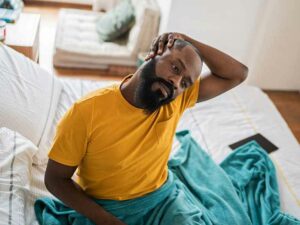Neck pain is a common problem that many people experience. There are a number of reasons why you might be experiencing neck pain, including poor posture, stress, and arthritis. In some cases, neck pain can be so severe that it makes it difficult to perform everyday tasks. If this sounds like you, then you might want to consider using at-home neck traction. This is a great way to relieve tension in your neck and improve your overall comfort. In this guide, we will discuss how to use at-home neck traction and the benefits that it can provide.
Contents
What Is Neck Traction?

Neck traction is a method of stretching and relaxing the muscles and tissues in your neck. It can be used to help relieve pain from conditions like herniated discs, degenerative disc disease, facet joint arthritis, and cervical spondylosis. Neck traction can also help to decrease neck stiffness and improve the range of motion.
There are main types of neck traction:
Manual traction: This is when someone else applies pressure to your neck to stretch it. You can do manual traction yourself by lying on your back and placing your hands on your head. Then, gently pull your head away from your body. It’s important to be gentle when doing manual traction and to stop if you feel any pain.
Mechanical traction: This is when you use a device to apply pressure to your neck to stretch it. For example, you might use an over-the-door traction device or an inflatable neck collar. For example, you might use an over-the-door traction device or an inflatable neck collar.
You can do mechanical traction at home or in a physical therapy office. If you’re doing it at home, be sure to follow the instructions that come with your device. And, as with manual traction, it’s important to stop if you feel any
Positional traction: This is when you position your body in a certain way to stretch your neck. For example, you might lie on your back with a pillow under your head. Or, you might sit in a chair and let your head fall forward.
Gravity traction: This is when you use gravity to stretch your neck. For example, you might lie on your back with a weight on your forehead. The weight applies pressure to your neck and stretches it.
Both positional and gravity traction can be done at home or in a physical therapy office.
It’s important to talk to your doctor or physical therapist before doing any type of neck traction. They can help you choose the right type of traction for your needs and make sure you’re doing it safely.
How Do You Use Neck Traction at home?

There are many different types of devices available. Do some research to find one that is comfortable for you and easy to use.
You will need a few things to get started with at-home neck traction:
A door
You will be attaching the traction device to the door. Make sure that the door is sturdy and will not move or slide when you pull on it. For example, you might use a heavy closet door or a bathroom door. A doorknob: You will need a doorknob to attach the device to the door. Make sure that the doorknob is sturdy and will not come loose when you pull on it.
Tightly woven rope
The rope should be strong and not stretchy. It should be at least 3 feet (91 cm) long. You will use the rope to attach the device to the door.
Pillow
You will need a pillow to rest your head on while you are using the device. For example, you might use a small pillow or a rolled-up towel.
Traction device
There are many different types of traction devices. You can purchase one online or at a medical supply store. This is the device that will be attached to the door and will hold your head in place. You can purchase a neck traction device online or at a medical supply store.
A towel
This will be used to cushion your head and make sure that the traction device does not rub against your skin.
A neck traction device: This is the device that will be attached to the door and will hold your head in place. You can purchase a neck traction device online or at a medical supply store.
Instructions
1. Place the pillow on the floor in front of the door. This will be where you rest your head while using the device.
2. Place the traction device on the floor next to the pillow.
3. Wrap the rope around the doorknob and tie it in knots so that it is secure. Make sure that the rope is not too tight or too loose.
4. Attach the other end of the rope to the traction device.
5. Place the traction device against the door with the doorknob in the middle. Make sure that the device is secure and will not move when you pull on it.
6. Sit on the floor next to the door with your head resting on the pillow.
7. Gently pull on the rope to start the traction. You should feel a gentle stretch in your neck. If you feel any pain, stop immediately and adjust the device.
8. Hold the traction for 15-20 minutes.
9. When you are finished, release the traction slowly by letting go of the rope. Do not move your head quickly or violently. Rest for a few minutes before getting up.
10. Repeat the process 2-3 times per day for best results.
Neck traction works by gently stretching the neck. This can help to relieve pain and tension in the neck and shoulders. It can also help to improve your range of motion.
If you experience any pain while using the device, stop immediately and consult your doctor.
Neck traction is a safe and effective way to relieve pain and tension in the neck and shoulders. However, it is important to use the device as directed. If you experience any pain, stop using the device immediately and consult your doctor.
Benefits
There are various benefits of using neck traction at home. They are as follows:
Reduces pain: One of the most important benefits of neck traction is that it can help to reduce pain. This is because it helps to take the pressure off of the spine and decompress the vertebrae.
Improves range of motion: Another benefit of neck traction is that it can help to improve your range of motion. This is because it helps to stretch the muscles and ligaments in the neck.
Reduces inflammation: Neck traction can also help to reduce inflammation. This is because it helps to stretch the muscles and ligaments, which can help to reduce swelling.
Improves blood circulation: Another benefit of neck traction is that it can help to improve blood circulation. This is because it helps to stretch the muscles and ligaments, which can help to improve blood flow.
Helps to decompress the spine: Neck traction can also help to decompress the spine. This is because it helps to take the pressure off of the spine and decompress the vertebrae.
Tips for using neck traction at home
If you are considering using neck traction at home, there are a few tips that you should keep in mind. They are as follows:
Check with your doctor first
It is always important to check with your doctor before you start any new at-home treatment, including neck traction. This is because you want to make sure that it is safe for you to do so.
Read the instructions carefully
Once you have checked with your doctor and gotten the green light to proceed, it is important to read the instructions carefully. This is because you want to make sure that you are using the neck traction device properly.
Start slowly
When you first start using neck traction, it is important to start slowly. This is because you want to make sure that your body is adjusted to the new treatment.
Increase the amount of time gradually
Once you have started slowly and your body has adjusted to the neck traction, you can then gradually increase the amount of time that you spend doing it.
Be consistent
In order to see the best results, it is important to be consistent with your neck traction treatments. This means doing it on a regular basis.
At-home neck traction can be an effective way to reduce pain, improve range of motion, and reduce inflammation. It is important to check with your doctor before starting any new at-home treatment and to be consistent with your treatments in order to see the best results.
Conclusion
It may be concluded that neck traction at home is a cost-effective, convenient and safe way to provide relief from neck pain. When used as directed, it can be an effective treatment for cervical radiculopathy, herniated discs, and other conditions that cause neck pain. Neck traction should only be used as directed by a healthcare professional. Physical Therapy help patients recover from pain. If you’re experiencing Back pain, Shoulder pain, Knee pain, Neck pain, Elbow pain, Hip pain, or Arthritis pain, a physical therapist at MantraCare can help: Book a physiotherapy session.


